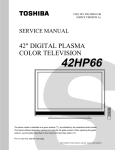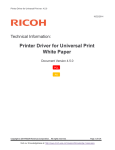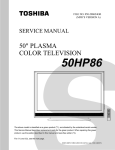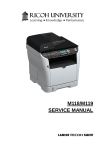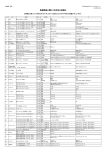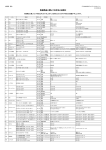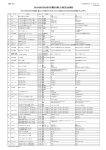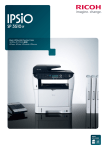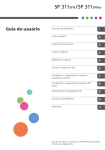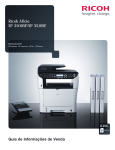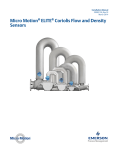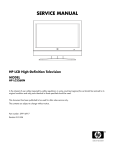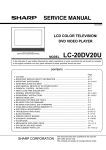Download Operating Instructions - Quick Guide: RN
Transcript
Quick Guide Names and Locations Using the Copier Function Using the Scanner Function Using the Fax Function Troubleshooting Removing Paper Jams Print Cartridge For safe and correct use, be sure to read “Safety Information” before using the machine. Table of Contents 2 1 Names and Locations • Exterior: SP 3510SF • Exterior: SP 3500SF • Interior • Control Panel 2 Using the Copier Function • Initial Screen and Basic Operation 8 • Advanced Photocopy Settings 11 3 Using the Scanner Function • Initial Screen and Basic Operation 14 • Advanced Scan Settings 21 4 Using the Fax Function • Initial Screen and Basic Operation for Sending a Fax 22 • Advanced Scan Settings 25 5 Troubleshooting • Error and Status Messages on the Screen 26 • Printing or Scanning Problems 30 • Fax Transmission Problems 31 6 Removing Paper Jams • Removing Internal/Tray 1/Tray 2 Jam • Removing Bypass Tray Jam • Removing Standard Tray/Duplex Unit Jam • Removing from the ARDF or ADF 7 Print Cartridge • Before Replacing the Print Cartridge 44 • Replacing the Print Cartridge 46 3 4 5 6 32 34 36 40 Names and Locations Exterior: SP 3510SF 1 2 12 3 11 10 9 4 5 8 7 6 CMF352 1 ARDF (Auto Reverse Document Feeder) Cover Open this cover to remove originals jammed in the ARDF. 2 Input Tray for the ARDF Open the cover and place stacks of originals here. 6 Tray 2 (option) 7 Tray 1 8 Bypass Tray Pull open to load paper. 9 Output Tray Printed paper is output here. 3 Output Tray for the ARDF 10 USB Flash Disk Port Originals scanned with the ARDF are output here. 4 Stop Fences Raise this fence to prevent paper from falling off. 5 Front Cover Open this cover to replace the print cartridge or remove jammed paper. Inser t a USB flash disk to store scanned files using the Scan to USB function. 11 Control Panel 12 Exposure Glass Place originals here sheet by sheet. 3 Names and Locations Exterior: SP 3500SF 1 2 3 11 12 10 9 4 5 8 7 6 CMF353 1 ADF (Auto Document Feeder) Cover Open this cover to remove originals jammed in the ADF. 2 Input Tray for the ADF Place stacks of originals here. 3 Output Tray for the ADF Originals scanned with the ADF are output here. 4 Stop Fences Raise this fence to prevent paper from falling off. 5 Front Cover Open this cover to replace the print cartridge or remove jammed paper. 4 6 Tray 2 (option) 7 Tray 1 8 Bypass Tray Pull open to load paper. 9 Output Tray Printed paper is output here. 10 USB Flash Disk Port Inser t a USB flash disk to store scanned files using the Scan to USB function. 11 Control Panel 12 Exposure Glass Place originals here sheet by sheet. Names and Locations Interior Print Cartridge Messages appear on the screen when the print cartridge needs to be replaced, or a new cartridge needs to be prepared. CMF354 CMF068 CMF072 5 Names and Locations Control Panel CMF355 1 Screen Displays current status and messages. 2 Scroll keys Press to move the cursor in the directions indicated by each scroll key. Pressing the [ ][ ] keys while the machine is in standby mode will display the menu for configuring the settings of the machine’s current operation mode (copier, scanner, or fax). 3 Number keys Use to enter numerical values when specifying settings such as fax numbers and copy quantities, or enter letters when specifying names. 4 [Clear/Stop] key •While the machine is processing a job: press to cancel the current job. •Whileconfiguringthemachine:press to cancel the current setting and return to standby mode. •While in standby mode: press to cancel temporary settings such as the image density or resolution. 5 [Start] key Press to scan, copy, or send a fax. 6 6 [OK] key Press to confirm settings or enter the next level of the menu tree. 7 [Escape] key Press to cancel the last operation or exit to the previous level of the menu tree. 8 Alert indicator Flashes yellow when the machine will require maintenance soon (such as replacing a print cartridge), or lights up red when a machine error occurs. When an alert is issued, check the messages on the screen and follow the instructions as provided in “Error and Status Messages on the Screen” on page 23. 9 Power indicator Remains lit while the power is on. It is unlit when the power is off. 10 Fax Received indicator Lights up when received faxes that have not been printed out exist in the machine’s memory. Flashes when the machine is unable to print out the faxes due to machine errors such as an empty paper tray or a paper jam. CMF356 1 One Touch buttons Press to select a scan or fax Quick Dial destination. 2 [Address Book] key Press to select a scan or fax destination from the Address Book. 3 [On Hook Dial] key Press to use on-hook dialing to check the destination’s status when sending a fax. 4 [User Tools] key Press to display the menu for configuring the machine’s system settings. 5 [Image Quality] key Press to select scan quality for the current copy, scan, or fax job. 6 [Shortcut to Func.] key Press to use the function pre-assigned for this key. For details, see “Administrator Settings”, User Guide. 8 Selection keys Press the key that corresponds to an item shown on the bottom line of the screen to select it. 9 [Density] key Press to adjust image density for the current copy, scan, or fax job. 10 [Reduce/Enlarge] key Press to specify the reduction /enlargement ratio for the current copy job, or the document size for the current scan job. 11 [Pause/Redial] key Press to insert a pause in a fax number, or display the last used scan or fax destination. 12 [Shift] key Press to switch between Quick Dial numbers 1 to 10 and 11 to 20 when specifying a scan or fax destination using the One Touch buttons. 7 [Copy]/[Facsimile]/ [Scanner] key Press to switch the machine’s operation mode. 7 Using the Copier Function Initial Screen and Basic Operation The following is the initial screen in copier mode. 1. Current status or messages 2. Current settings 3. Selection key items Displays the functions you can use by pressing the corresponding selection keys. 4. Copy quantity • The original in the ARDF or ADF takes precedence over the original on the exposure glass if you place originals both in the ARDF/ADF and on the exposure glass. • You may need to log in to the machine by entering a user name and password. For details, see"WhenLDAPAuthenticationisSpecified",User Guide. Press the [Copy] key. CMF131 8 Place the original face down on the exposure glass or face up in the ARDF/ADF. Lift the ARDF/ADF carefully without holding the input tray. Otherwise, the ARDF/ADF might be damaged. ARDF ADF CMF351 CMF350 Exposure Glass CMF048 • If necessary, configure advanced photocopy settings. For more details, see “Advanced Photocopy Settings” on page 11. To make multiple copies, enter the number of copies using the number keys • The maximum number of copies is 99. 9 Using the Copier Function Initial Screen and Basic Operation Press the [Start] key. If you are using the SP 3510SF model, depending on the machine's settings, "Set Back Side" appears on the screen when using the exposure glass. •Ifyouwanttocopythebacksideofthe original, proceed to the next step. •Ifyouwanttoendthejob,press[ ]. A copy will be output. CMF141 Turn over the original on the exposure glass, and then press the [Start] key. A 2-sided copy will be output, and "Set Front Side" appears on the screen. •If you want to copy the front side of the original again, turn over the original on the exposure glass, and then return to step 4. •Ifyouwanttoendthejob,press[ ]. If a certain period of time passes before you press [ ], the copying may finish automatically. • To cancel photocopying, press the [Copy] key, press the [Clear/Stop] key, and then press [Yes] for confirmation. • You can change the paper tray for the current job by pressing the [ ][ ] keys. You can also select to change the paper tray automatically according to the paper size (A4 or Letter). • You can enable the machine to copy both sides of original with the exposure glass by changing the machine's default setting. For details, see "Configuring the Machine Using the Control Panel", User Guide. • If a paper jam occurs, printing stops after the current page has been printed out. After the jammed paper is removed, printing restarts from the jammed page automatically. • If a scanning jam occurs in the ARDF or ADF, copying is canceled immediately. In this case, copy the originals again starting from the jammed page. • For information about originals, see “Getting Started”, User Guide. • For information about removing jammed paper, see “Removing Paper Jams” on page 32. 10 Using the Copier Function Advanced Photocopy Settings v Making Enlarged or Reduced Copies You can specify the reduction or enlargement ratio for the current job. There are two ways to set the scaling ratio: using a preset ratio or manually specifying a custom ratio. 1. Press the [Reduce/Enlarge] key. 2. Press [Reduce], [Enlarge], or [Zoom]. 3. For [Reduce] or [Enlarge], press the [ ][ ][ ][ ] keys to select the desired ratio. For [Zoom], specify the desired ratio using the number keys. 4. Press the [OK] key. v Combining Pages and Making 2-sided Copies You can combine multiple pages (2 or 4 pages) of an original onto a single page. Also, with the SP 3510SF model, you can scan 2-sided originals and make 2-sided copies. • This function is only available when the original is set in the ARDF or ADF, not when it is set on the exposure glass. • For combine and 2-sided copying, the paper size must be A4, Letter or Legal. • For 2-sided copying, the paper type must be thin, plain, recycled, color, preprinted, prepunched, thick paper 1, or letterhead. Below are examples of copy modes. Select a copy mode according to your original and how you want the copy outputs to appear. For more details, see "Combining Pages and Making 2-sided Copies", User Guide. Example of combined copying Copy Landscape Portrait Original CMF250 11 Using the Copier Function Advanced Photocopy Settings Example of 2-sided copying Original Copy Top to Bottom Top to Top Top to Bottom Landscape Portrait Top to Top CMF261 Use this procedure to set copy mode for the current job. 1. Press [Dup/Comb]. Alternatively, you can press the [Shortcut to Func.] key if this function is assinged for the key. 2. Press the [ ][ ] keys to select the desired copy mode, and then press the [OK] key. 3. Press the [ ][ ] keys to select page and binding orientations, and then press the [OK] key. The screen will show the selected copy mode. • For details about how to configure the [Shortcut to Func.] key, see "Administrator Settings", User Guide. • You can make 2-sided copies manually with the SP 3500SF model. For details, see "Making 2-sided Copies Manually (Type 1 model)", User Guide. 12 v Adjusting Image Density You can adjust the image density for the current job. 1. Press the [Density] key. 2. Press the [ ][ ] keys to select the desired density level, and then press the [OK] key. (Lightest) (Darkest) v Selecting the Document Type You can select the best document type for the original that you are scanning. 1. Press the [Image Quality] key. 2. Press the [ ][ ] keys to select the desired document type, and then press the [OK] key. Mixed Text Photo for originals with both text and photographs for originals with text only for originals with photographs only • For more details about the copier function, see “Using the Copier Function”, User Guide. • If you would like to change the default settings of the machine, see “Configuring the Machine Using the Control Panel”, User Guide. 13 Using the Scanner Function Initial Screen and Basic Operation The following is the initial screen in scanner mode. 1. Current status or messages 2. Current scanning mode and settings 3. Selection key items •When“SpecifyDest.”isdisplayed: Scan to E-mail, Scan to FTP, or Scan to Folder functions can be used. •When“SaveScnDatatoUSB”isdisplayed: A USB flash disk is inserted in the machine, and the Scan to USB function can be used. • If a USB flash disk is inserted in the machine, scanning operations other than Scan to USB are disabled on the control panel. • Scan to E-mail, Scan to FTP, and Scan to Folder destinations must be registered using WebImageMonitorinadvance(theScantoUSBfunctiondoesnotrequiredestinations registered). For details, see “Using the Scanner Function”, User Guide. • To send files via e-mail, SMTP and DNS settings must be configured properly in advance. Fordetails,see“ConfiguringtheMachineUsingWebImageMonitor”,User Guide. • It is recommended that you call the receiver and confirm with them when sending important documents. • Certain types of USB flash disks cannot be used for the Scan to USB function. • The original in the ARDF or ADF takes precedence over the original on the exposure glass if you place originals both in the ARDF/ADF and on the exposure glass. • You may need to log in to the machine by entering a user name and passowrd. For details, see“WhenLDAPAuthenticationisSpecified”,User Guide. • The Scan to USB function may be disabled by the machine’s default setting. For details, see “Administrator Settings”, User Guide. 14 v Basic Operation for Scan to E-mail/FTP/Folder Place the original face down on the exposure glass or face up in the ARDF/ADF. Lift the ARDF/ADF carefully without holding the input tray. Otherwise, the ARDF/ADF might be damaged. ARDF ADF CMF351 CMF350 Exposure Glass CMF048 Press the [Scanner] key, and then press the [Address Book] key. Alternatively, you can press the [Shortcut to Func.] key if this function is assinged for the key. CMF140 15 Using the Scanner Function Initial Screen and Basic Operation Press the [ ][ ] keys to select [Search Address Book], and then press the [OK] key. If you want to search for a specific entry by its name, enter the first letters of the name using the number keys, and then press the [OK] key. Each time you enter a character, the display changes to show the matching name. Search for the desired destination by pressing the [ ][ ] keys to scroll the Address Book, and then press the [OK] key. Whenyouspecifyascandestination,themachine’sscansettingschange automatically according to the information registered for that destination in the Address Book. If necessary, you can change the scan settings using the control panel. For more details, see “Advanced Scan Settings” on page 21. Press the [Start] key. CMF141 Depending on the machine’s settings, you may see the screen on the right on the display when scanning from the exposure glass. If you see this screen, proceed to the next step. If you have more originals to scan, place the next original on the exposure glass, and then press [Yes]. Repeat this step until all originals are scanned. When all originals have been scanned, press [No] to start sending the scanned file. 16 v Basic Operation for Scan to USB Insert your USB flash disk into the USB flash disk port. CMF066 • This machine does not support the use of USB flash disks connected to external USB hubs. Insert your USB flash disk directly into the USB flash disk port. Press the [Scanner] key. “Loading...” appears on the display. Wait until the display changes to show “Save Scn Data to USB” (the duration depends on your USB flash disk). CMF132 17 Using the Scanner Function Initial Screen and Basic Operation Place the original face down on the exposure glass or face up in the ARDF/ADF. Lift the ARDF/ADF carefully without holding the input tray. Otherwise, the ARDF/ADF might be damaged. ARDF ADF CMF351 CMF350 Exposure Glass CMF048 • If necessary, configure advanced scan settings. For more details, see “Advanced Scan Settings” on page 21. 18 Press the [Start] key. Depending on the machine’s setting, the following screen appears on the display. CMF141 Black-and-white scanning mode: Color or gray scale scanning mode: Press the appropriate selection key for the desired file format. Depending on the machine’s settings, you may see the screen on the right on the display when scanning from the exposure glass. If you see this screen, proceed to step 6. If not, proceed to step 8. If you have more originals to scan, place the next original on the exposure glass, and then press [Yes]. Repeat this step until all originals are scanned. When all originals have been scanned, press [No] to start sending the scanned file. Confirm that “Ready” appears on the display. The scanned file is created in the root directory of the USB flash disk. Remove the USB flash disk from the machine. 19 Using the Scanner Function Initial Screen and Basic Operation • To cancel scanning, press the [Scanner] key, and then press the [Clear/Stop] key. The scan files are discarded. • You can configure the machine to scan documents in black and white, color, or grayscale by changing the machine’s default settings. For details, see “Configuring the Machine Using the Control Panel”, User Guide. • If paper is jammed in the ARDF/ADF or an access error to the USB flash disk occurs, the scan job will be discarded. Remove the jammed paper and scan the entire originals again. • For details about how to configure the [Shortcut to Func.] key, see “Administrator Settings”, User Guide. • You can also specify a destination using the One Touch buttons, [Pause/Redial] key, or from an LDAP server. For details, see “Using the Scanner Function”, User Guide. • For information about originals, see “Getting Started”, User Guide. • For information about removing jammed paper, see “Removing Paper Jams” on page 32. 20 Using the Scanner Function Advanced Scan Settings v Specifying the Scanning Size You can specify the scanning size according to the size of the current original. 1. Press the [Reduce/Enlarge] key or [Scn Size]. 2. Press the [ ][ ] keys to select the size of the original, and then press the [OK] key. If you would like to specify a custom scanning size, see “Specifying the scanning size according to the size of the original”, User Guide. v Adjusting Image Density You can adjust the image density for the current job. 1. Press the [Density] key. 2. Press the [ ][ ] keys to select the desired density level, and then press the [OK] key. (Lightest) (Darkest) v Specifying Resolution You can specify the scan resolution for the current job. 1. Press the [Image Quality] key. 2. Press the [ ][ ][ ][ ] keys to select the desired resolution, and then press the [OK] key. v Specifying the scanning side according to the original (SP 3510SF) If you are using the SP 3510SF model, you can specify the machine to scan both sides of original automatically using the ARDF. 1. Press [Original]. 2. Press the [ ][ ] keys to select the desired scanning method, and then press the [OK] key. Selectthesidesoftheoriginal(1sideor2-sides)toscan.Whenscanning2-sides,selectthe page and binding orientations according to the original. • For more details about the scanner function, including how to scan originals from a computer (TWAINscanning),see“UsingtheScannerFunction”,User Guide. • If you would like to change the default settings of the machine, see “Configuring the Machine Using the Control Panel”, User Guide. 21 Using the Fax Function Initial Screen and Basic Operation for Sending a Fax The following is the initial screen in fax mode. 1. Current status or messages 2. Current settings 3. Selection key items 4. Current date and time CMF102 • Make sure to establish a telephone line connection, and configure the settings for fax transmission in advance. • The original in the ARDF or ADF takes precedence over the original on the exposure glass if you place originals both in the ARDF/ADF and on the exposure glass. • It is recommended that you call the receiver and confirm with them when sending important documents. • You may need to log in to the machine by entering a user name and passowrd. For details, see“WhenLDAPAuthenticationisSpecified”,User Guide. Press the [Facsimile] key. CMF133 22 Place the original face down on the exposure glass or face up in the ARDF/ADF. Lift the ARDF/ADF carefully without holding the input tray. Otherwise, the ARDF/ADF might be damaged. ARDF ADF CMF351 CMF350 Exposure Glass CMF048 • If necessary, configure the advanced scan settings. For details, see “Advanced Scan Settings” on page 25. Enter the fax number (up to 40 characters) using the number keys. If the machine is connected to the telephone network through a PBX, make sure to enter the outside line access number before the fax number. 23 Using the Fax Function Initial Screen and Basic Operation for Sending a Fax Press the [Start] key. •Dependingonthemachine’ssettings,you may be prompted to enter the fax number again. In this case, re-enter the number within 30 seconds, press [OK], and then press the [Start] key. If the fax numbers do not match, go back to step 3. •Depending on the machine’s settings, you may be prompted to place another original on the exposure glass. In this case, proceed to the next step. CMF141 If you have more originals to scan, press [Yes] within 60 seconds, place the next original on the exposure glass, and then press [OK]. Repeat this step until all originals are scanned. If you do not press [Yes] within 60 seconds, the machine will start to dial the destination. When all originals have been scanned, press [No] to start sending the fax. • To cancel sending a fax, press the [Facsimile] key, and then press the [Clear/Stop] key. • A fax number can contain 0 to 9, pause, “ “, “ “, and space. • If necessary, insert a pause in a fax number. The machine pauses briefly before it dials the digits following the pause. • To use tone services on a pulse-dialing line, insert “ ” in a fax number. “ ” switches the dialing mode from pulse to tone temporarily. • If paper is jammed in the ARDF or ADF, the jammed page has not been scanned properly. WhenthemachineisinImmediateTransmissionmode,resendthefaxstartingfromthejammed page.WheninMemoryTransmissionmode,scantheentireoriginalsagain. • You can also specify destinations using the One Touch buttons, Speed Dial function, LDAP server, or [Pause/Redial] key. In addition, you can broadcast a fax to multiple destinations. For details, see “Using the Fax Function”, User Guide. • By default, the machine is set to print a transmission report automatically after a fax transmission. To change this setting, see “Configuring the Machine Using the Control Panel”, User Guide. • For information about originals, see “Getting Started”, User Guide. • For information about removing jammed paper, see “Removing Paper Jams” on page 32. 24 Using the Fax Function Advanced Scan Settings v Adjusting Image Density You can adjust the image density for the current job. 1. Press the [Density] key. 2. Press the [ ][ ] keys to select the desired density level, and then press the [OK] key. Normal Dark Light v Specifying Resolution You can specify the scan resolution for the current job. 1. Press the [Image Quality] key. 2. Press the [ ][ ] keys to select the desired resolution, and then press the [OK] key. Standard for originals with normal-sized characters Detail for originals with small print Photo for originals with images v Specifying the scanning side according to the original (SP 3510SF) If you are using the SP 3510SF model, you can specify the machine to scan both sides of original automatically using the ARDF. • If the machine is in Immediate Transmission mode, this function is not available. For details, see “Sending a Fax”, User Guide. 1. Press [Original]. 2. Press the [ ][ ] keys to select the desired scanning method, and then press the [OK] key. Selectthesidesoftheoriginal(1sideor2-sides)toscan.Whenscanning2-sides,select the page and binding orientations according to the original. • For more details about the fax function, see “Using the Fax Function”, User Guide. • If you would like to change the default settings of the machine, see “Configuring the Machine Using the Control Panel”, User Guide. 25 Troubleshooting Error and Status Messages on the Screen “X” indicates the parts of the messages that appear differently depending on a specific situation, such as paper sizes, paper types, or tray names. Message (alphabetical order) 26 Causes Solutions ADF Orig. Misfeed Open ADF Cover and remove paper. An original has been jammed inside the ARDF or ADF. •Removejammedoriginals, and then place them again. See "Removing from the ARDF or ADF" on page 40. •Checktheoriginalsaresuitable for scanning. See "Placing Originals", User Guide. Check Paper Size The paper size set for the document differs from the size of the paper in the tray. Press [FormFeed] to begin printing, or press [JobReset] to cancel the job. Check Paper Type The paper type set for the document differs from the type of the paper in the tray. Press [FormFeed] to begin printing, or press [JobReset] to cancel the job. Cover open A cover is open. Close the cover completely. Dest. is not Programmed No Quick Dial entry is associated with the One Touch button you pressed. •PressadifferentOneTouch button. •Assignaregistereddestination to the One Touch button. See "Registering Scan Destinations", User Guide. Failed to Access File Press Clear key The Scan to USB function failed because the machine could not access the USB flash disk properly. Use a USB flash disk that is not password- or write-protected. Failed to Create File Press Clear key The Scan to USB function failed because there was not enough memory on the USB flash disk. Use a USB flash disk with enough memory. Message (alphabetical order) Causes Solutions Internal Misfeed Paper has been jammed in the machine. Remove the jammed paper. See "Removing Paper Jams" on page 32. Memory Almost Full Memory has almost reached capacity during sort copy. If several originals are still to be scanned, it is recommended to start printing now, and copy the remaining originals separately. If originals are being scanned from the ARDF or ADF, remove any remaining pages from the ARDF or ADF. Misfeed: Bypass Tray Paper has been jammed in the bypass tray. Remove the jammed paper. See “Removing Paper Jams” on page 32. Misfeed: Dup. Unit Remove Paper Paper has been jammed in the duplex unit. Remove the jammed paper. See "Removing Paper Jams" on page 32. Misfeed: Stnd. Tray Paper has been jammed in the paper exit area. Remove the jammed paper. See "Removing Paper Jams" on page 32. Misfeed: Tray 1 Paper has been jammed in the tray 1 paper input area. Remove the jammed paper. See "Removing Paper Jams" on page 32. Misfeed: Tray 2 Paper has been jammed in the tray 2 paper input area. Remove the jammed paper. See "Removing Paper Jams" on page 32. Out of Paper: X The indicated tray has run out of paper. Load paper to the indicated tray. See “Loading Paper”, User Guide. Print Cart. Set Error The print cartridge has not been installed or has not been installed correctly. Reinstall the print cartridge. See "Print Cartridge" on page 44. 27 Troubleshooting Error and Status Messages on the Screen Message (alphabetical order) 28 Causes Solutions Replace Required Soon: Print Cartridge The print cartridge is almost empty. Prepare a new print cartridge. Replacement Required: Print Cartridge The machine has run out of toner. Replace the print cartridge. See “Print Cartridge” on page 44. Unsupported Device Please Remove The Scan to USB function failed because a USB device other than a USB flash disk or a USB flash disk with an unsupported file system was used. Use a USB flash disk that is compatible with the Scan to USB function. Unsupported Device Press Clear key The Scan to USB function failed because a USB device other than a USB flash disk or a USB flash disk with an unsupported file system was used. Use a USB flash disk that is compatible with the Scan to USB function. Unsupported USB Hub Please Remove The Scan to USB function failed because a USB device other than a USB flash disk or a USB flash disk with an unsupported file system was used. Use a USB flash disk that is compatible with the Scan to USB function. USB Disconnected Press Clear key The Scan to USB function failed because the USB flash disk was removed before the operation could be completed. Check that the USB flash disk is securely inserted in the machine. Do not pull out the USB flash disk until "Ready" appears on the display. Message (alphabetical order) Causes Solutions USB Memory Overflow Press Clear key The Scan to USB function failed because there was not enough memory on the USB flash disk. Use a USB flash disk with enough memory. Write Protect Press Clear Key The Scan to USB function failed because the machine could not access the USB flash disk properly. Use a USB flash disk that is not password- or write-protected. 29 Troubleshooting Printing or Scanning Problems v Images are too dark or too light on the copied pages or scanned files Image density is too dark or too light. Adjust the image density. v Copied pages or scanned files are dirty Ink or correction fluid on the original is not dry. Before placing originals on the exposure glass, make sure that ink or correction fluid is dry. v The same area is dirty whenever making copies or scanning files The exposure glass or ARDF/ADF is dirty. Clean the exposure glass or ARDF/ ADF. Clean the parts indicated with arrows with a soft damp cloth and then wipe the same parts with a dry cloth to remove any remaining moisture. For more details, see “Cleaning”, User Guide. Exposure Glass ARDF/ADF CMF093 30 CMF094 Troubleshooting Fax Transmission Problems v Cannot send or receive faxes The modular cable may be disconnected. Make sure that the modular cable is correctly connected. For more details, see “Connecting to a Telephone Line”, User Guide. v Cannot receive faxes even when sending them is possible • The print cartridge is empty. Replace the print cartridge. For more details, see “Print Cartridge” on page 44. •Atrayisempty.Loadpaperintothetray.Formoredetails,see“LoadingPaper”, User Guide. v A fax you sent appears blank when received The original was placed upside down. Place the original in the correct orientation. For more details, see “Placing Originals”, User Guide. v Cannot print the received faxes •Thepapertrayisempty.Loadpaperinthepapertray.Formoredetails,see“Loading Paper”, User Guide. •ThetrayforprintingfaxesdoesnotcontainA4,Letter,orLegalsizepaper.Change the tray setting, and load paper of the appropriate size. For more details, see “Fax Feature Settings”, User Guide • If you cannot solve the problem, contact your local sales or service representative. 31 Removing Paper Jams Removing Internal/Tray 1/Tray 2 Jam CAUTION • The inside of this machine becomes very hot. Do not touch the parts labelled “ “ (indicating a hot surface). • Some of this machine’s internal components get very hot. For this reason, take care when removing misfed paper. Not doing so could result in burns. • Whenremovingjammedpaper,makesurenottotraporinjureyourfingers. • Jammed paper may be covered in toner. Be careful not to get toner on your hands or clothes. • Toner on prints made immediately after clearing a paper jam may be insufficiently fused and can smudge. Make test prints until smudges no longer appear. • Do not forcefully remove jammed paper, as it may tear. Torn pieces remaining inside the machine will cause further jams and possibly damage the machine. • Paper jams can cause pages to be lost. Check your print job for missing pages and reprint any pages that did not print out. Pull tray 1 halfway out, and check for jammed paper. If there is jammed paper, remove it carefully. CMF067 Carefully slide tray 1 back in until it stops. If paper is loaded in the bypass tray, remove the paper. Close the bypass tray. Push the side button to open the front cover, and then carefully lower it. 32 Carefully pull out the print cartridge horizontally, holding its center. •Donotshaketheremovedprintcartridge. Doing so can cause remaining toner to leak. •Place the print cartridge on paper or similar material to avoid dirtying your workspace. CMF069 Lifting the guide plate, remove the jammed paper carefully. CMF070 Slide the print cartridge in horizontally. When the cartridge can go no further, raise it slightly and push it fully in. Then push down on the cartridge until it clicks into place. CMF071 Using both hands, carefully push up the front cover until it closes. • If paper is jammed in tray 2 but is difficult to locate, pull out tray 2 to remove it. After removing the paper, carefully push tray 2 all the way back inside the machine. • Whenclosingthefrontcover,pushtheupperareaofthecoverfirmly.Afterclosingthecover, check that the error is cleared. 33 Removing Paper Jams Removing Bypass Tray Jam CAUTION • The inside of this machine becomes very hot. Do not touch the parts labelled “ “ (indicating a hot surface). • Some of this machine’s internal components get very hot. For this reason, take care when removing misfed paper. Not doing so could result in burns. • Whenremovingjammedpaper,makesurenottotraporinjureyourfingers. • Jammed paper may be covered in toner. Be careful not to get toner on your hands or clothes. • Toner on prints made immediately after clearing a paper jam may be insufficiently fused and can smudge. Make test prints until smudges no longer appear. • Do not forcefully remove jammed paper, as it may tear. Torn pieces remaining inside the machine will cause further jams and possibly damage the machine. • Paper jams can cause pages to be lost. Check your print job for missing pages and reprint any pages that did not print out. If paper is jammed in the bypass tray input area, remove the jammed paper carefully. CMF073 Close the bypass tray. Push the side button to open the front cover, and then carefully lower it. Carefully pull out the print cartridge horizontally, holding its center. •Donotshaketheremovedprintcartridge. Doing so can cause remaining toner to leak. •Place the print cartridge on paper or similar material to avoid dirtying your workspace. 34 CMF069 Lifting the guide plate, remove the jammed paper carefully. CMF070 Slide the print cartridge in horizontally. When the cartridge can go no further, raise it slightly and push it fully in. Then push down on the cartridge until it clicks into place. CMF071 Using both hands, carefully push up the front cover until it closes. • Whenclosingthefrontcover,pushtheupperareaofthecoverfirmly.Afterclosingthecover, check that the error is cleared.. 35 Removing Paper Jams Removing Standard Tray/Duplex Unit Jam CAUTION • The inside of this machine becomes very hot. Do not touch the parts labelled “ “ (indicating a hot surface). • Some of this machine’s internal components get very hot. For this reason, take care when removing misfed paper. Not doing so could result in burns. • Whenremovingjammedpaper,makesurenottotraporinjureyourfingers. • Jammed paper may be covered in toner. Be careful not to get toner on your hands or clothes. • Toner on prints made immediately after clearing a paper jam may be insufficiently fused and can smudge. Make test prints until smudges no longer appear. • Do not forcefully remove jammed paper, as it may tear. Torn pieces remaining inside the machine will cause further jams and possibly damage the machine. • Paper jams can cause pages to be lost. Check your print job for missing pages and reprint any pages that did not print out. Open the rear cover. CMF074 Remove the jammed paper carefully. CMF075 Close the rear cover. 36 Pull tray 1 halfway out, and check for jammed paper. If there is jammed paper, remove it carefully. CMF067 Pull tray 1 out completely with both hands. Place the tray on a flat surface. CMF077 Push the lever. Pushing the lever lowers the duplex transport unit. CMF078 If there is jammed paper, carefully remove it. CMF079 37 Removing Paper Jams Removing Standard Tray/Duplex Unit Jam With the duplex transport unit still lowered, carefully slide tray 1 back in until it stops. CMF080 If paper is loaded in the bypass tray, remove the paper and close the bypass tray. Push the side button to open the front cover, and then carefully lower it. Carefully pull out the print cartridge horizontally, holding its center. •Donotshaketheremovedprintcartridge. Doing so can cause remaining toner to leak. •Place the print cartridge on paper or similar material to avoid dirtying your workspace. CMF069 Lifting the guide plate, remove the jammed paper carefully. CMF070 38 Slide the print cartridge in horizontally. When the cartridge can go no further, raise it slightly and push it fully in. Then push down on the cartridge until it clicks into place. CMF071 Using both hands, carefully push up the front cover until it closes. • Whenclosingthecovers,pushthecoversfirmly.Afterclosingthecovers,checkthatthe error is cleared. 39 Removing Paper Jams Removing from the ARDF or ADF CAUTION • Whenremovingjammedpaper,makesurenottotraporinjureyourfingers. Illustrations of the ARDF model (SP 3510SF) are used in the following procedure unless otherwise specified. Open the ARDF/ADF cover. CMF081 Gently pull the jammed original to remove it. Be careful not to pull the original too hard, as it may rip. CMF082 If you cannot pull out the jammed original easily, move the lever slightly to the machine rear, and then raise it to unlock the paper feed roller. ADF ARDF CMF083 40 CMF120 Lift the paper feed roller slightly and pull it out toward you. ADF ARDF CMF116 CMF084 Gently pull the jammed original to remove it. CMF085 If you cannot pull out the jammed original easily, raise the input tray to see if the original is jammed in the output area. CMF086 Gently pull the jammed original to remove it. CMF087 41 Removing Paper Jams Removing from the ARDF or ADF Put the paper feed roller back in with the roller part facing downwards. ADF ARDF CMF117 CMF088 Lower the lever to lock the paper feed roller. ADF ARDF CMF089 CMF124 Close the ARDF/ADF cover. CMF090 42 Lift the ARDF/ADF, and if there is original remaining in the ARDF/ADF, gently pull the jammed original to remove it. Be careful not to hold the input tray when lifting the ARDF/ADF, for the tray might be damaged. CMF091 Close the ARDF/ADF. 43 Print Cartridge Before Replacing Print Cartridge WARNING • Do not incinerate toner (new or used) or toner containers. Doing so risks burns. Toner will ignite on contact with naked flame. • Do not store toner (new or used) or toner containers anywhere near naked flames. Doing so risks fire and burns. Toner will ignite on contact with naked flame. • The following explains the warning messages on the plastic bag used in this product’s packaging. • Keep the polythene materials (bags, gloves, etc.) supplied with this machine away from babies and small children at all times. Suffocation can result if polythene materials are brought into contact with the mouth or nose. • Do not use the cleaner to suck spilled toner (including used toner). Sucked toner may cause firing or explosion due to electrical contact flickering inside the cleaner. However, it is possible to use the cleaner designed for dust explosion-proof purpose. If toner is spilled over the floor, sweep up spilled powder toner slowly and clean remainder with wet cloth. CAUTION • Do not crush or squeeze toner containers. Doing so can cause toner spillage, possibly resulting in dirtying of skin, clothing, and floor, and accidental ingestion. • Store toner (new or used), toner containers, and components that have been in contact with toner out of reach of children. • If toner or used toner is inhaled, gargle with plenty of water and move into a fresh air environment. Consult a doctor if necessary. • If toner or used toner gets into your eyes, flush immediately with large amounts of water. Consult a doctor if necessary. • If toner or used toner is swallowed, dilute by drinking a large amount of water. Consult a doctor if necessary. • Whenremovingjammedpaperorreplacingtoner,avoidgettingtoner(neworused) on your clothing. If toner comes into contact with your clothing, wash the stained area with cold water. Hot water will set the toner into the fabric and make removing the stain impossible. • Whenremovingjammedpaperorreplacingtoner,avoidgettingtoner(neworused) on your skin. If toner comes into contact with your skin, wash the affected area thoroughly with soap and water. • The inside of this machine becomes very hot. Do not touch the parts labeled “ “ (indicating a hot surface). 44 • Store print cartridge in a cool dark place. • The actual number of printed pages varies depending on image volume and density, number of pages printed at a time, paper type and size, and environmental conditions such as temperature and humidity. Toner quality degrades over time. Early replacement of the print cartridge might be necessary. Therefore, we recommend you always keep a new print cartridge ready. • For good output quality, the manufacturer recommends that you use genuine toner from the manufacturer. • The manufacturer shall not be responsible for any damage or expense that might result from the use of parts other than genuine parts from the manufacturer with your office products. 45 Print Cartridge Replacing Print Cartridge v Messages for Preparing Print Cartridge Prepare a new print cartridge when “Replace Required Soon: Print Cartridge” appears on the screen. • To purchase print cartridges, contact your service representative. v Messages for Replacing Print Cartridge Replace the print cartridge when “Replacement Required: Print Cartridge” appears on the screen. • Do not allow paper clips, staples, or other small metallic objects to fall inside the machine. • Do not expose the print cartridge without its cover to direct sunlight for a long time. • Do not touch the print cartridge’s photo conductor unit. CMC013 • If toner runs out, you cannot print until the print cartridge is replaced. 46 Replacing Print Cartridge If paper is loaded in the bypass tray, remove the paper and close the bypass tray. Push the side button to open the front cover, and then carefully lower it. Carefully pull out the print cartridge horizontally, holding its center. •Donotshaketheremovedprintcartridge. Doing so can cause remaining toner to leak. •Place the old print cartridge on paper or similar material to avoid dirtying your workspace. CMF069 Take the new print cartridge out of the box, and then take it out of the plastic bag. CMC081 Place the print cartridge on a flat surface, and then remove the protection sheet. CMC019 47 Print Cartridge Replacing Print Cartridge Hold the print cartridge and shake it from side to side five or six times. Even distribution of toner within the bottle improves print quality. CMC020 Slide the print cartridge in horizontally. When the cartridge can go no further, raise it slightly and push it fully in. Then push down on the cartridge until it clicks into place. CMF071 Carefully push up the front cover until it closes. Be careful not to trap your fingers. After closing the front cover, wait until the initial screen is displayed. Put the protective sheet you removed in step 5 on the old print cartridge. Then, put the old print cartridge into the bag, and then put it into the box. CMC083 • Make sure to cover the old print cartridge with the protective sheet for recycling and environmental purposes. • Comply with the print cartridge recycling program, whereby used print cartridges are collected for processing. For details, ask your sales or service representative. 48 Print Cartridges Appendix Where to Inquire Contact your sales or service representative for further information about topics covered in this manual or to inquire about topics not covered in this manual. Saving Energy This machine is equipped with the following Energy Saver modes: Energy Saver mode 1 and Energy Saver mode 2. In Energy Saver mode, the machine’s power consumption is reduced from its normal state. If Energy Saver modes 1 and 2 are enabled, the machine will enter Energy Saver mode 1 if it has been idle for 30 seconds. If the machine continues to be unattended, it will then enter Energy Saver mode 2 after specified period of time (1 minute by default). The machine takes about 10 seconds to recover from Energy Saver mode 1, and about 20 seconds to recover from Energy Saver mode 2. According to your convenience, you can enable or disbale Energy Saver modes, as well as configure the timer for entering Energy Saver mode 2, in [Energy Saver Mode] under [Admin. Tools]. • Even if Energy Saver mode 2 is enabled, the machine will not enter Energy Saver mode 2 for two hours if [Low Humidity Mode] under [System Settings] is enabled. However, the machine will enter Energy Saver mode 1 as normal (even when Energy Saver mode 1 is not enabled). • For details about Energy Saver modes, see “Administrator Settings”, User Guide. • For details about [Low Humidity Mode], see “System Settings”, User Guide. 49 Appendix v Opening Manuals The manual CD-ROM provided with the machine contains manuals in HTML format and PDF. Install the manuals before using the machine. There are two ways to view the manuals. •Double-clickthemanualicononyourdesktop. •Onthe[Start]menu,pointto[AllPrograms],pointto[ProductName],andthen click [Manual Name]. • The menu options may appear differently, depending on the options chosen during installation. • For details about installing the manuals, see “Guide to the Machine”, User Guide. 50 Quick Guide Names and Locations Using the Copier Function Using the Scanner Function Using the Fax Function Troubleshooting Removing Paper Jams Print Cartridge EN GB EN US © 2011 M119-8511



















































